West Texas Wind, Dorothy Scarborough’s The Wind, Texas Quilts, and Madness
by
Sherry Lutz Zivley
November 23, 2009
Wind and Madness in Literature and Domestic Art That the combination of the isolation and the dust storms of West Texas can drive people crazy is demonstrated both in women's fiction and in their domestic arts. Dorothy Scarborough's novel, The Wind and Victor Sjöström's silent film (based on Scarborough's novel and staring Lillian Gish) depict a young woman's descent into madness as a result of moving from a comfortable life in Virginia to the isolation, hardships, and terrible windstorms of West Texas.
The International Quilt Festival in Houston, Texas, in 1986 featured Texas quilts. Some quilts that were made by women living in isolation in West Texas around 1900 display symptoms of madness similar to the madness depicted in The Wind.
I grew up in Dallas during a period in which we never experienced a dust storm. We had blue northers (fronts which approached rapidly from the north or northwest and which brought strong. dark blue-grey winds and radical drops in temperature). For me blue northers were never threats but merely harbingers of gingerbread and cocoa in front of the fireplace. Only later, when I lived for two years in Las Cruces, New Mexico, did I learn about dust storms that pitted or completely removed paint from cars and first frazzled your nerves, then gradually drove you crazy. Consequently I recognized the emotional truths that are depicted in Dorothy Scarborough’s novel The Wind [ii] and the 1927 silent film based on the novel (directed by Victor Seastrom and starring Lillian Gish) and in some quilts made by West Texas pioneer women.
Hurricanes have frequently been used in fiction and film to emphasize plots in which innocent people fall victim to the violence of criminals or psychotics, for example in Key Largo, Cape Fear, and The Mean Season. In contrast, powerful winds, such as the mistrals of Provence, France; the soroccos of northern Africa; and the mariahs of Montana and the western United States[iii] are often associated with mental turmoil or even madness.
The dust storms and blue northers of West Texas, according to Barbara Quissell, “are comparable to the mistral of southern France and the sirocco of northern Africa, other violent winds which are said to drive individuals to extreme and uncharacteristic actions."[iv] As Joe R. Eagleman[v] points out, “continued drought can change the landscape.... The dust storms of the l930s covered fences with mounds of dust; a dust storm 500 km in diameter can carry 100 million tons of dust.” Likewise, a “norther may reach a speed of 40 knots, and...[can] produce[ ] clouds of dust.”[vi] Although in this century the dust storms that produced the dust bowl and contributed to the Great Depression are well known, the winds and dust storms of the West Texas drought of l885-86—the period in which The Wind was set—were far more severe. Scarborough’s representations of the wind in her novel are not exaggerated. As Carole Slade points out, “Numerous types of destructive winds, including cyclones, tornadoes, and northers… did continually threaten the lives and property of pioneers on unprotected Texas ranges” (86). Eagleman explains that in an “intense longwave cyclone. . . strong winds [can] pick up considerable dust from the dry soil in eastern Colorado, New Mexico, Oklahoma, and Texas” (34) and can create extreme–nightlike–darkness (35).
The blue northers of Texas, which Karolyn Bresenham and Puentes describe in Lone Stars: A Legend of Texas Quilts, 1836-1936, sometimes bring in “enough cold air to drop the temperature from 90o to 30o in less than an hour.”[vii] These northers get their name not only from their temperature but also because of “the dark blue haze [that is] created by the advancing cold current against the warmer southern wind” Texas Almanac: 1958-1959, 163). The storm can be darker still if it has picked up dust. In Scarborough's novel, Letty describes one blue norther that begins as “ a puny, cloud, slight and fragile, touching the prairie’s rim,” but which “grew and darkened. Swiftly it spread over the sky until it blotted out the blue, till it hung, a black pall, over the wide heavens. It happened so quickly...that Letty could scarcely believe it” (171). She describes “the icy chill of a sudden (171) drop in temperature” and explains that “night was on them almost immediately, for the clouds had blotted out the daylight, wiping out even the [usual] brief wintry dusk” (172).
Scarborough’s novel, The Wind, shows the effect that the hardships of pioneer homesteading had on women, most of whom came from places whose landscape and weather were benign or even luxurious. Scarborough’s novel demonstrates the erosion that the combination of wind and isolation can cause to a person’s sanity. In the course of the novel, Letty is orphaned at eighteen with no relatives to take care of her in her native Virginia. She is persuaded by her pastor to travel to Sweetwater, Texas to live with her cousin, who is a rancher there. As the train carries her westward, she becomes more and more depressed by the landscape—by its desiccation, by its emptiness, by the skeletons of dead cattle she sees along the way, and most of all, by its fierce winds. The wind drives her first to marry a man she cannot love; second, to have an affair with a man she cannot trust; third, to murder him with a typical West Texas weapon—a rifle; fourth, to bury him only to have his body gradually unearthed by the wind; and finally, to go completely mad and rush out across the prairie in a windstorm to her death.
Of the very few critics who have discussed The Wind, two utilize feminist viewpoints. Barbara(?) Quissel presents a brief biography of Scarborough, focuses on the realism and historical accuracy of the novel’s presentation of the Western pioneer experience, and argues that the “feminist viewpoint [of the novel] is a secondary theme” (187). She compares the novel with the 1927 Victor Seastrom silent film, and considers the significance of the fact that the point of view is that of “the interior mind” (191). Carol Slade argues that the wind in the novel represents a patriarchal society; she interprets the powerful and pervasive wind as a symbol of “the masculine force . . . [that] can incapacitate a woman for authorship” (Slade 86).[viii]
Certainly Scarborough distinguishes between men’s and women’s ability to deal with the wind: Gram’ma Powers explains to Letty that the wind is “the hardest thing a woman is up against on the plains. Men don’t know what it means to us. Their nerves ain’t like ourn” (194). In Scarborough’s introduction to the novel she says, “The winds were cruel to women that came under their tyranny. They were at them ceaselessly, buffeting them with icy blasts in winter, parching their skins and roughening their hair, and trying to wear down their nerves by attrition, and drive them away” (3).
As an extremely sensitive eighteen-year-old, Letty is vulnerable to suggestions and predisposed to internalize what Roddy, the stranger she meets on the train to Sweetwater, tells her. He states that “the wind is the worse thing,” and that “it’s ruination to a woman's looks and nerves pretty often. It dries up her skin till it gets brown and tough as leather. It near 'bout puts her eyes out with the sand it blows in 'em all day. It gets on her nerves with its constant blowing—makes her irritable and jumpy” (21). (I might have thought this description excessive had I not experienced West Texas dust storms, seen that the wind could in a few hours remove all the paint from the side of a car facing the wind, and experienced the way that the wind first made people uneasy, but could in a couple of days make them feel extremely anxious—almost crazy.) He also tells her how dangerous tornadoes are. Roddy also plants the idea that will encompass Letty: that the wind is “a devil” (24). She immediately assimilates these ideas, conceiving of the wind as “a terror that might pass by day or night, to leave death and devastation in its path! It the day, when you could see its frightfulness,–or in the night when you could only hear it roaring, and imagine!” (26). When she detrains in Sweetwater she feels that “the wind swooped at her like a mad malevolence” (37) and admits that “the wind got on my nerves” (44). Instead of recognizing the beauty in seeing “incredible distances in all directions(?),” she “feels queer to be out in the open with so much space about” (53). She is also susceptible to Lige Hightower’s assertion that “I reckon there are folks that’d go loco for lonesomeness” (54).
Letty becomes obsessed with what she considers the “demonic wind” (105), a wind that “roared like a thousand demons let loose from the pit” (172). She personifies the wind as “a demon steed, racing like a black shadow across the plain, a lonely, terrible figure, neighing in the night” (155), and believes it is determined to destroy her. She intensifies her fear by incanting again and again a song she had learned in Virginia: “Lord, I don’t want to die in a storm” (156). She begins to think in the kind of teleological causality that schizophrenics use, i.e., they believe that “every act, every event occurs because it is willed or wanted either by [a] person…or by something that has become personified” (Atieti 241)–in Letty’s case, the wind. Arieti even states, “If a storm occurs, if the wind blows it is solely because someone wants it to (242, italics Arieti’s).
Letty not only blames all her suffering on the malevolent wind, but develops irrational beliefs about it that gradually become obsessive hallucinations. She believes:
the wind was a demon that had driven them all crazy; that had put false thoughts in Cora’s [her cousin’s wife, who hated Letty] mind, making her stir up…trouble….. The wind was determined to destroy her, because she feared it so! It was after her, and she couldn’t escape it!
She saw the wind as a black stallion with mane a-stream, and hoofs of fire, speeding across the trackless plains, deathless, defiant!...A phantom, riderless horse, whom no mortal would ever ride–that no lariat flung by human hands could capture! His proud neck arching, his eyes glancing flames, he raced toward her across the sand—supernatural, satanic, the wind of the North! (175)
At a later point in the novel she describes the wind differently, as
“whirling curtains of dust, veils that writhed and twisted, hung like cloth of gold from the heavens, as high as she could see. The wind was no longer naked and invisible. It had clothed itself with those swirling veils that revealed its obscene antics, its horrific gestures. It was a thing unbearable to see the wind!" (197, italics Scarborough’s).
Letty believes that “no human being, no wild beast even, could be so tricky and so crafty and so cruel as the wind and the sand” (198), and that the wind would “laugh and shriek at you” 199). She believes that she has angered the wind because she can read the its mind (334), and that “the wind knew what…[her] thoughts were” (335).
Letty demonstrates a major symptom of schizophrenia, adualism, which Arieti defines as “[the] lack of the ability to distinguish between the two realities, that of the mind and that of the external world” (Arieti 278). The fact that she says that she “held long dialogues with persons imagined or actual” (208), and that she imagines mirages of “green trees and still lakes” (260) shows that she can no longer distinguish between a hallucination and the real, a major symptom of schizophrenia, according to Arieti. She also demonstrates another symptom of schizophrenia, “an increased acuity of perception” (Arieti 279), as she becomes “acutely aware of all that went on around her” (Scarborough 261). Her observations match Arieti’s analysis, that “in many . . . cases of acute schizophrenia the patient experiences an increased acuity of perception” (Arieti 279).
Letty also experiences another basic symptom of schizophrenia, a sense of separation and alienation from his or her own body. Emotionally healthy persons usually feel their bodies to be “alive, real, and substantial." and feel themselves to be "alive, real, and substantial" (Laing 68). They perceive themselves as "embodied" (Laing 68). In contrast, schizophrenics experience themselves as "unembodied" (Laing 68). Unlike "those 'ordinary' people who feel in moments of stress partially dissociated from their bodies," they "go through life...detached from their bodies" (Laing 68). To them, "the body is felt more as one object among other objects in the world" or as "a false self which a detached, disembodied, 'inner,' 'true' self looks on...with tenderness, amusement, or hatred."
Letty experiences “a queer remoteness from reality, as if only her body were there, and she herself were far away” (181). She also exhibits symptoms of bipolar illness in that she alternatively experiences “despondency so profound that it seemed she could never climb up to spiritual peace” and moments of “unreasonable exhilaration” in which her “spirit would walk on rainbow clouds, [and] her whole body would tingle with joy.” These mood swings suggest that she may also be suffering from bi-polar illness.
At the novel’s climax and conclusion, after she has murdered Wirt Roddy and buried him, unsuccessfully,
because the wind blew away the sand that covered his body, the final words of the novel are
“with a laugh that strangled on a scream, the woman sped to the door, flung it open and rushed out. She fled across the prairies like a leaf blown in a gale, borne along in the force of the wind that was at last to have its way with her” (337).
At this point, having allowed herself to be driven completely mad by the wind, Letty goes out into the storm and to her death.
Certainly the living conditions, deprivations and hardships which Scarborough describes throughout her novel were no exaggeration. Bresenham explains that “Farms and ranches were . . sometimes more than a day’s rid from civilization” (19), and “their lives were...reduced to the bare essentials of their environment–the rattlesnake, the Texas son, the windmill, the log cabin, the schoolhouse” (1836-1936, 17). Likewise, the women who lived “in the Panhandle or the plains [ ] watched the Dust Bowl [of the 1930’s]blow away the hopes and dreams that lay in the topsoil the wind swept away into black clouds as high as mountains” (1936-1986, 11), just as it had during previous droughts. A pioneer woman had to try to make a home, as did Letty, in a log cabin that was “just a box-house . . . [s]et up in makeshift fashion with a rock at each corner, and an occasional one along the walls,” in a yard with “no flowers, no grass” (182) and whose interior walls were papered with newspapers ( 190). And some had to live in dugouts. MaryTaylor Bunton, . in Texas Tears and Texas Sunshine,[ix][x] exclaims, “Can you . . . imagine people living in dirt houses? That was what a ‘dugout’ was–just a good-sized square hole dug back into the south side of a hill . . . . There were no windows in the dugout and only a dirt floor. In times of storm a wagon sheet or tarpaulin was fastened across the doorway” (230). Nevertheless, the women quilted. And although Thomas K. Woodard and Blanche Greenstein explain, writing fifty years later, that “quilting gave women a profound sense of accomplishment, of being able to do something at a time when the laber force was idle and to piece something together when many people’s lives were falling apart” (35), an anonymous woman who lived through the Great Depression puts it more bluntly: “Lady, we didn’t have no money. Nobody had no money. All we had was time. People made them quilts because there wasn’t nothing else to do!” (Quoted in 1936-1986, 29), they quilted because they had to live by the saying, “Use it up, wear it out, make it do, or do without” (1836-1936, 19).
In
l984, the International Quilt Festival in Houston, Texas, featured an
enormous number of Texas quilts, some of which were later described in
Bresenham and Puentes‘s Lone Stars: A Legend of Texas Quilts,
1836-1936, and its companion volume, which covers the years
1936-1986. Most of the
quilts in this quilt show were traditional with serene and comforting
designs. Such quilts usually have formal balance, use
either pastel or primary or secondary colors, and are usually serene,
happy. Two examples are the following. Below, on the left,
is a design called “flower garden.” On the right is traditional
appliquéd desigh, which usually showed flowers and/or vines.


At that 1984 quilt show I was stunned by a half a dozen or so quilts that instantly struck me as psychotic. Most of them were from the l9th century, made by women who had followed their husbands from the East Coast to the hardships of life of West Texas homesteading. These very untraditional quilts by West Texas women unnerved me because they seemed crazy, truly psychotic. Unlike what are called "crazy quilts," which are artfully designed, elaborately embroidered, constructed of silk and velvet. Traditional crazy quilts were intended to show the elaborate stichery of their creators and were used not for keeping warm in bed but for display in parlors—often as lap quilts.
Unlike crazy quilts, which are not crazy at all, some of these West Texas quilts were. I think even the photographs of them are troubling to look at, and to confront them in their full size was even more unsettling. They gave the impression that the minds that conceived them must be very troubled indeed. Each of the following pages shows a troubling West Texas quilt from the turn of the century.
Quilt #1
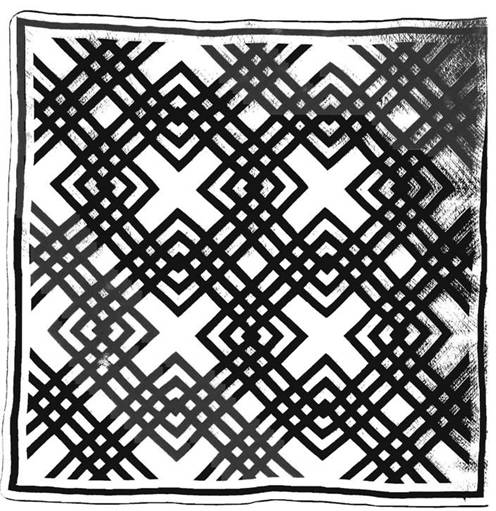
The severity of the black and white Carpenter's Square Quilt (Quilt #1)[xi] suggests a very stark, colorless, but painfully overly-controlled view of the world. The desigh is neither a labyrinth (in which one can only follow one path from entrance to exit) nor a maze (in which one can easily get lost but out of which one can eventually find one's way), but a series of crisscrossing, concentric, right-angled figures in any one of which one would be permanently imprisoned. Both the starkness of the lack of color and the encapsulating design seems to represent an inflexible world, a world of severely limited possibilities, almost a world of incarceration such as that which women like Letty in Scarborough's novel experienced daily.
The next two quilts are of a type called “postage stamp quilts,” which means they are made from individual pieces that are no larger than postage stamp.. In both cases, because the pieces are triangular, they are the size of half postage stamps. Although most postage stamp quilts seem quite orderly, these do not.
Quilt #2
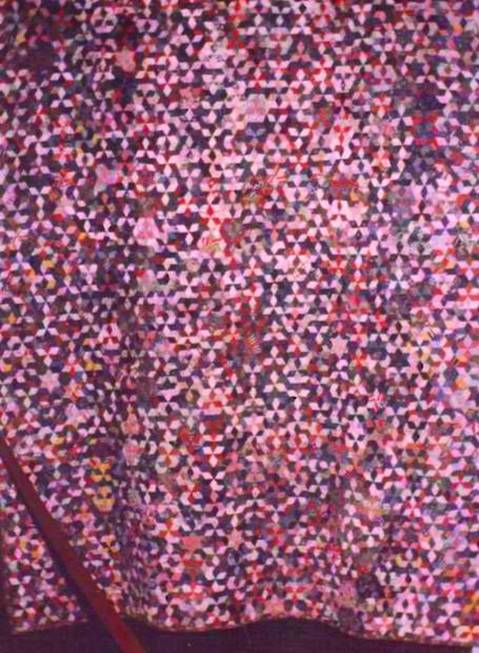
Quilt #2[xii] is constructed of tiny triangles, often grouped as six-pointed stars. Although the quilt seems to tend toward some overall design, everywhere there are violations of that design. The quilt's movement is never resolved at any focal point or in any overall pattern. The quilt conveys a troubling confusion to the viewer and implies a similar confusion in the quilt maker.
Quilt #3
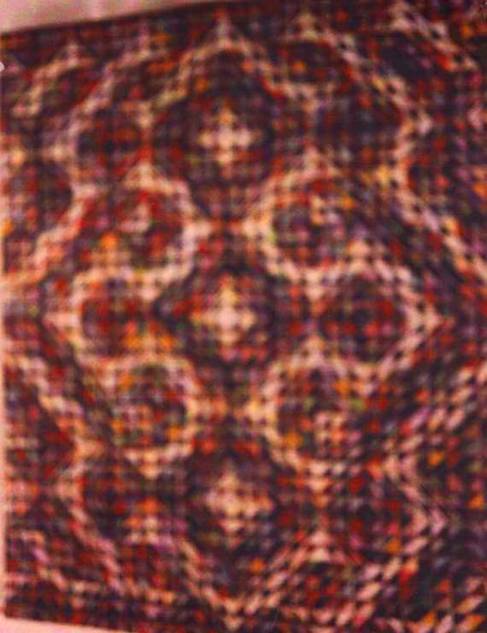
The other postage stamp quilt (Quilt #3),[xiii] constructed of thousands of triangles, has a clearly planned design. Yet the design, with its wavelike pattern, which seems, like op-art, to be in constant (op-art-like) ever-changing, rippling motion, makes a viewer feel dizzy and almost seasick. And, if looking at these quilts for just a few minutes is unsettling to the viewer, how much more unsettling it must have been for the quilt makers to look at them for the length of time it would have taken to construct them.
The following three quilts are of a type usually called "target quilts" and convey the same implicit threat that is suggested by Jasper John's target paintings.
Quilt #4
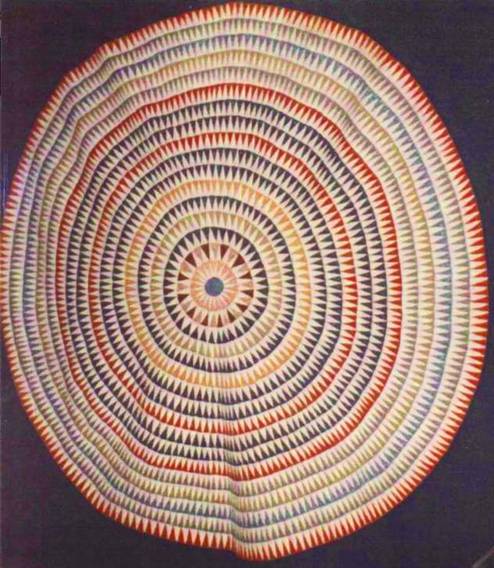
Quilt #4 (circa 1900) is clearly a target with a bull's eye that is surrounded by concentric circles which emphasizes the center of the target. Quilt #4[xiv] unnerved me, and I said to myself, “It’s the evil eye.” Then before I uttered my reactions to the quilts, the Turkish woman I was attending the show with, exclaimed, “My God, its the evil eye!” Silvano Areiti has said that the art of schizophrenic patients often represented “the evil eye” that schizophrenics believe is watching them. [xv] Arieti explains,
The eye symbolizes the world, or the other, any person other than yourself, the other...who is there not to commune with you but to watch. And to watch means to scrutinize, to blame, to condemn, to reject you an to destroy your sense of self-regard, your privacy, and your human dignity. (358)
Such perceptions are like Hetty’s conviction that the wind watches her, knows her thoughts, and is out to destroy her.
Quilt #5
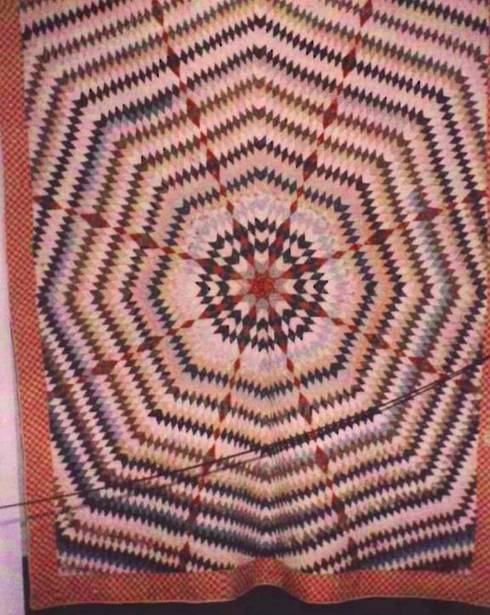
Quilt #5 (circa 1890-1900) is made of concentric octagons around the eye center, which suggest an unbearable excess of pain. Furthermore, these quilts are dominated by the vivid colors: reds (muted in the photograph), blacks, and whites—the visually assaulting colors of the German Expressionists and of Sylvia Plath's most psychotic poetry.
Quilt #6
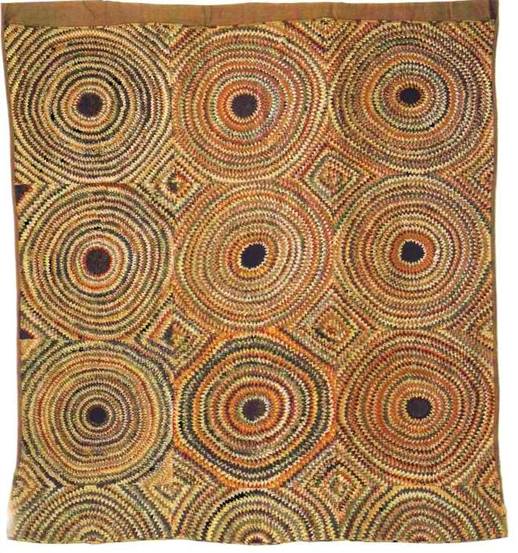
In Quilt #6 (circa 1910) the red bull's eyes or evil eyes seem to have multiplied, out of control, much as did the water-carrying broom of "The Sorcerer's Apprentice" or the increasing number of creeping women the speaker in "The Yellow Wallpaper" hallucinates. The result is that quilt presents a multiplicity of evil eyes—eyes that seem to be watching one from a variety of vantage points.
Quilt #7
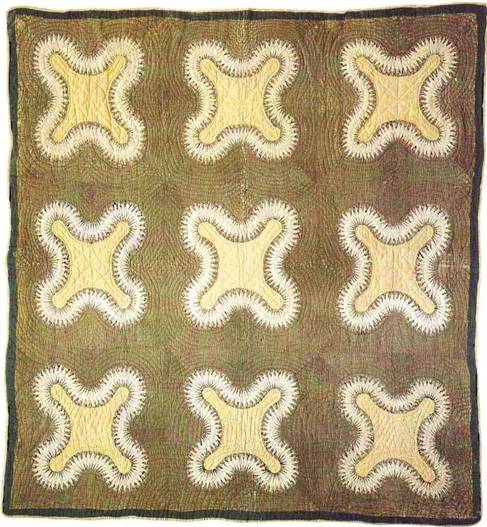
Quilt #7,[xvi] does not assault the reader with either loud colors, irregularity, or concentric design, but, nevertheless, I think creates anxiety. Its somewhat uneasy circular designs have harsh, serrated edges, the quilt’s colors are dull and muted, have little contrast, and, in fact, are rather ugly. Only when one reads its title, “Rattlesnakes” does one fully understand its deadly threat of multiple and perhaps multiplying rattlesnakes.
Quilt #8
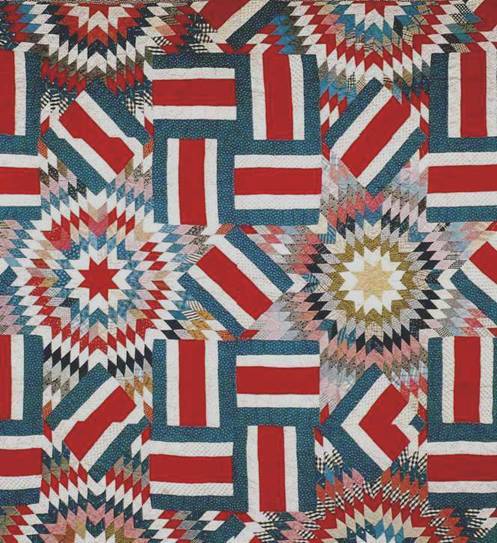
Quilt #8 is, perhaps, the strangest of them all. The use of the colors red, white, and blue seem upbeat, patriotic, happy. But the extreme irregularity of the patterns are self-contradictory. That what appear the dominant forms, the eight-pointed stars are of a variety of colors—a few reds, whites, and blues, but are predominantly of muted, greyed colors is strange. That the quite had two full-circle starts, two that are half-circiles, and not quite half circles is strange. The two swastika-like red-white and blue patters are made of identical squares, but that all the other red, white, and blue squares are cut into random patterns make for a whole that is painfully at odds with itself. There is no focal point at which the viewers eye can settle, and the whole effect is like the optical illusions that are made to shift as one looks at them.
All of these quilts are extremely troubling, especially when one realizes how long their creators would have had to look at them during their piecing and quilting. These quilts are a far cry from most American quilts, whose order and serenity suggest the safety, security, satisfaction, and sanity of a comfortable and happy American home. These turn of the century West Texas quilts communicate the
the agony and loneliness of the isolated women pioneers who created them
I have experienced the degree to which a West Texas windstorm’s intensity, lastingness, physical and mental abrasiveness, and apparent malevolence can effect a person emotionally. Scarborough certainly demonstrates that the wind can drive a lonely woman mad. And various quilts by Texas pioneer women suggest the degree to which the isolation and winds and isolation of Texas had troubled them.
[i]What Kesey says about the fictional Wakonda, Oregon is equally true of West Texas, especially in the era when it was being settled by pioneers and cattlemen, separated from their nearest neighbor by many miles.
[ii]Austin, Texas: University of Texas Press, 1925. Rpt. 1979.
[iii]These winds are the subject of the song "They Call the Wind Mariah" from Paint Your Wagon.
[iv]" Dorothy Scarborouth’s “Critique of the Frontier Experience in The Wind” Women, Women Writers, and the West (Troy, NY: Whitson, 1979, 179-80.
[v]Severe and Unusual Weather, 2nd ed. (Lenexa, KS: Trimedia Publishing Co., 1990).
[vi]Encyclopedia Americana.
[vii]Karolyn Patterson Bresenham and Nancy O'Bryant Puentes. Texas Stars: A Legend of Texas Quilts, 1936-1986. Vol. I. (Austin, Texas: U Texas Press, 1986), 70.
[viii]"Authorship and Authority in Dorothy Scarborough's The Wind," Studies in American Fiction 14 (1986).
[ix](San Antonio, Texas: Naylor Co., 1939. Quoted in Bresenham, 1836-1936.
[x]Twentieth Century Quilts, 1900-1950 (New York: E. P. Dutton, 1988) 35.
12The Carpenter's Square Quilt was made around 1895 by Marth Harrient Kincaid Wilson in McKinney, Colin County, Texas.
13This triangle postage stamp quilt was pieced around 1890. Although dates are available for this and the following quilts, complete documentation is temporarily unavailable, but is recorded in the Texas Quilt Archives and will eventually be available.
Received: January 1, 2009, Published: November 23, 2009. Copyright © 2009 Sherry Lutz Zivley
